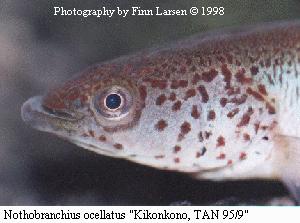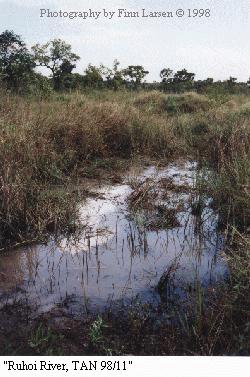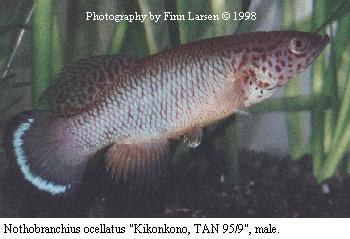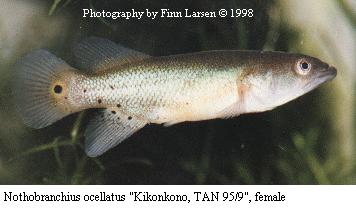Nothobranchius ocellatus (Seegers, 1985)

Finn, wake up! You must raise the bidding now. The place is the Netherlandic exhibition in 1996, and we are in the middle of the auction. I thought that the Notho-class was just over, and I took a nap! A bag of peat with eggs of Nothobranchius ocellatus "Kikonkono, TAN 95/9" has just been donated. Exactly that species has been on my want list during my hunt on the big Nothos. Many people were very interested but I succeeded in buying the peat and eggs.
Some history
Nothobranchius ocellatus was caught for the first time by L. Seegers, G. Eggers and C. Kasselman on December 31st. 1980 near the northern gate to Selous Game Reserve on the road to Kibiti between Rufiji River Camp and the village Mtanza in the eastern part of Tanzania.
They caught only two fish. As both fishes were estimated to be females, one of them was killed and preserved. In the preservative the colours of the fish were magnified and they doubted whether it actually was a male that was caught. The female was taken alive. Later it was lost as the tank cracked and the water ran out - it was pictured first, however.
Around 1986 N. ocellatus was caught again by L.Seegers. The fish got the location name "Bogayomo", and it is probably of these fishes that were in the hobby for some years. It is questionable whether fishes from this collecting trip still are in the hobby.

In June 1995 Ruud Wildekamp, Brian Watters and Ian Sainthouse were on their very successful collecting trip to Tanzania. Again N. ocellatus was caught. This time three pairs were caught. These fish, up 15 cm long, were given the name "Kikonkono, TAN 95/9". Two pairs went with Brian Watters to Canada and the third pair to the Netherlands. Only the pairs that were taken to Canada were bred.
In June 1997 Ruud Wildekamp, Brian Watters and Barry Cooper were on a collecting trip to Zanzibar and the south-eastern part of Tanzania. Again N. ocellatus was caught. This time from five different localities: "Makubwa River, TAN 97/29", "Mohoro, TAN 97/35", "Kitonga South, TAN 97/36", "Ruhoi River, TAN 97/42" and "Soga, TAN 97/45". As the fishes from the five localities looked quite similar and as the fishes were of considerable size it was decided to take fishes only from two of the localities: "Makubwa River, TAN 97/29" and "Kitonga South, TAN 97/36".
Again in May 1998 N. ocellatus was caught. This time by Brian Watters, John Rosenstock, Mike Agnew and the writer. The fishes were given the collecting name "Ruhoi River, TAN 98/11". Three males and two females were caught, and all the fishes came, with the writer, to Denmark. When arrived in Denmark the fishes were in a very bad condition and some of the fishes had some disease like "fin-rot". But the fishes are breeding and I already have collected some eggs, so I hope I will succeed to spread this fish in the hobby.
Based on the fish from 1980, Lothar Seegers described the species in his booklet "Prachtgrundkärpflinge. Die Gattung Nothobranchius" He also set up the genus Paranothobranchius. The genus consists of only Paranothobranchius ocellatus. L. Seeger's argument for setting up this new genus is that the appearance of the fish and their behaviour are so different from all other known Nothobranchius.
In 1992 in the February volume of "Ichthyological Exploration of Freshwaters" Ruud Wildekamp and Richard Haas take a look at the N. microlepis complex and the status of Paranothobranchius ocellatus. Based on their investigations they find no reason to set up Paranothobranchius as a separate genus but suggest that N. ocellatus, together with N. microlepis and the two newly described species N. fasciatus and N. bojiensis get status as a subgenus and get the name Nothobranchius (Paranothobranchius) ocellatus.
In "Killifishes of the World. Old World Killies II" L. Seegers again argues that Paranothobranchius shall be a independent genus consisting of Paranothobranchius ocellatus. Probably, this fight on genus/subgenus is not finished.

Name and distribution
The genus/subgenus, name Paranothobranchiusis is composed of Parens, Latin for father, Nothos is Greek for false, spurious, Branchion is Greek for gill. Freely translated this is the forefather of fishes with false gills. The species name ocellatus comes from the Latin word ocellus that means eye and refer to the spot (eyespot) on the females caudal fin.
N. ocellatus come from shallow temporary pools in eastern Tanzania. N. ocellatus is often found together with N. melanospilus and N. janpapi. The locality "Ruhoi River, TAN 98/11" was the 28th of May a small pool approximately 4 by 2 meters and about 20-25 cm deep and situated in high grass. Besides N. ocellatus we also caught N. eggersi, N. annectens, N. melanospilus, N. janpapi, Aplocheilichthys kongoranensis, Ctenopoma muriei, a barb and a cichlid.
Description
In body shape this fish doesn't look like any other known Nothobranchius.
Both sexes are big and rather long fishes, without looking coarse, perhaps on account of the small scales. Both sexes has relative large fins. The dorsal and the anal fins are placed far back on the body. The head is rather long and pointed with a big mouth and large visible teeth. The mouth is pointed forward and not as much upwards like other Nothobranchius. The fishes look and behave like a pike. The head of the male is silvery with a touch of turquoise. The head has a lot of big brown to reddish brown dots. The top side, from the head to the dorsal fin, is brown to reddish brown with a faint touch of turquoise. Very small scales. The scales on the sides of the body are turquoise with brown to reddish brown borders. Small scales. The abdomen is light, nearly silvery, with very small scales. The dorsal fin is farthest in turquoise with a heavy pattern of brown to reddish brown dots. Farthest out is the dorsal fin is greyish with a fringed edge. The anal fin is farthest in reddish brown with faint brown dots. Farthest out is the anal fin is greyish with a fringed edge. The caudal fin is farthest in grey with a touch of yellow, then a thin dark grey band, after that a wide white band and the fin finishes with a wide black border. The pectoral fins are transparent with faint white tips. The ventral fins are transparent with white tips. The eyes are greyish brown.

The female is greyish brown to golden with silvery to white abdomen. On the base of the caudal fin the female has a big spot (eyespot). Lowest on the hind part of the body, on the area from the anal to the caudal fin, the female is spotted with black dots.
Maintenance and breeding
In spite of its size N. ocellatus is not very space demanding. The fishes are not especially active and most of the time they stay still, just waiting for a prey, like a small pike. I keep the fishes in tanks with a rather big bottom area but a low water level. Under these conditions it is possible to keep a male and 1-3 females in only 20 litres of water. Most important is that the fishes can get away from each other and hide totally between plants, stones etc. Both sexes are fairly aggressive and the females don't stand any nonsense if they are bigger or stronger than the male. Note, however, that N. ocellatus is much more peaceful than expected, having regard to what is reported about the other big killifishes, such as the big Cynolebias species. Under these conditions I change half of the water twice a week. The fish eat a lot and the water gets dirty very quickly. Therefore it is very important to make frequent changes of water.

When my first fish became sexually mature they were put together for breeding in the same way as I breed my other Nothobranchius species; tap water with one tablespoonful of Atlantic salt per 10 litre, peat at the bottom and some Java ferns, Microsorium pteropus. To my great delight there were many eggs when I first dried the peat. Obviously, it was easy to breed N. ocellatus, if given sufficient food! After about a month I checked the peat to see what was happening with the eggs. I could not find a single egg. I checked the other bags of peat also: same result. Panic! At that time I had four males and six females, this allowed me to do some experiments. The worst thing would be if the food failed. The fishes also aged quickly. I did not know how old N. ocellatus would live to. With annual fishes you can have healthy and fine fish. A week after they may be dead owing to age. I have tried to breed N. ocellatus in rain water, tap water, tap water with Atlantic salt and combinations of these types. My tap water is about 24 DH and pH 7,5. I have tried tanks with light and without light. Until now the best way I have found is to separate the male from the females for some days and then put them together in a tank without light and with clean water and clean peat on the bottom. The fish are kept together for 12-24 hours and should not be fed in the tank. After the spawning I take the peat out of the tank. Then I search the peat and remove the eggs. The eggs are put on new moist peat in small plastic containers in order to control the eggs and remove fungussed eggs. I cannot find any difference in the number of surviving eggs whether I have used rain water, tap water or "salt water". I have even used tap water with six tablespoonful of Atlantic salt per 10 litre during a strong Oodinium attack and still the eggs survived. It seems that the eggs are sensitive to light and very sensitive to pollution of the water and the peat where the eggs are stored.
In spite of these experiments I still loose a lot of eggs. Only about 10 % of the eggs survive the first 14 days. After 14 days I loose only few eggs. As the eggs lie freely upon the peat it is, in return, easy to control the eggs and with some experience it is possible to see exactly when the eggs are ready for hatching. With a storage temperature of 26º to 27°C the eggs are ready for hatching after 6 to 8 weeks. At lower temperature the eggs take longer time to develop. It is seldom that I miss fry because of too early or too late hatching or fry become belly sliders. This compensates for the small number of surviving eggs. The eggs are about 3 mm, oval shaped and amber coloured. The eggs are hatched in this way: eggs and peat are placed in a plastic tray or a little tank and the peat is drenched with fresh, cool tap water 15º to 18°C so that the peat is covered with 1 to 2 cm. Each egg is hatched separately. (I have tried to hatch several eggs together. Everything looks fine in the beginning but after a few hours I saw two of the fry fighting each other, biting each others jaws and shaking the adversary.) The newly hatched fry which are about 10mm have to be fed immediately with newly hatched Artemia, Cyclops, small water fleas or small black mosquito larvae that are eaten with a ravenous appetite. After a few days the fry are moved to a small tank, only with a few snails for eating the dead food. Now it is important to feed and change the water. With feeding 2-3 times a day and changing of a third to half of the water daily the fry grow well. After 3 to 4 days the young can eat white mosquito larvae. At this time it may be a good idea to give frozen red mosquito larvae so that the fishes, at an early stage, learn to eat dead food. It is difficult to teach older fish to eat new kinds of food and it may be difficult to obtain live food for 10 to 15 adult N. ocellatus every day. After about 14 days I move the young fish to some larger tanks. The tanks are divided into several departments separated by glass. This provides better room for the young and makes the changing of water easier. At the same time the young get used to each other, a practical thing when the fishes are bred later. It is an advantage that the fish know that not everything alive must be eaten!
Now its up to ones fantasy to catch food. As the fishes grow up they loose interest in smaller food. I have, with success, been feeding the fishes with water woodlice, water tigers, larvae from different kinds of May flies and other water insects. Raw prawns without the shell, ants, earthworms and compost-worms. I have succeeded in using compost-worms. It is the easiest and best food I have tried. To be sure to obtain enough food, I have set up a compost-container and thus ensured food in all sizes most of the year. If the young are well fed and with regular changes of water, they grow 1 to 1.5mm a day so a considerable amount of food is needed. When newly hatched all the fry have an eye spot on base of the caudal fin regardless of their sex. Although they are growing fast it takes fairly long time before the young are sexually mature. With some experience it is possible to tell the sexes from the shape of the anal fin. The females anal fin is sharp whereas the males is more rounded. It is easier if both sexes are present for comparison. Not before the fishes are about 5 to 6 weeks old do the males begin to show some colours and at that time the young are 65 to 70mm. First the eye spot disappears and the red-brown dots on the head begin to appear. Later the adult colours on the body and fins begin showing. When the fishes are sexually mature they grow slower. The females start producing eggs and the male use their energy to impress each other and the females. My fish have reached a size of about 95mm for both sexes. The fish seldom live more than 9 to 10 months.
Remarks
Although I have now bred N. ocellatus through several generations I am far from satisfied with the fact that only few eggs survive. I will continue my experiments and hope to find a more effective way of breeding N. ocellatus.
| Literature |
|
|
| Lüke, K.-H. |
1993 |
Nothobranchius ocellatus (Seegers, 1985) |
|
|
DKG-J., XXV page 1-4. |
| Ooms, P. |
1993: |
Nothobranchius ocellatus (Seegers, 1985) |
|
|
K.F.N. Killi Bericht 261. |
| Rosenstock, J. |
1993: |
Nye fisk - nye navne. |
|
|
Killibladet nr. 1 1993, page 1-5. |
| Rosenstock, J. |
1994: |
Nothobranchius fra nord til syd. |
|
|
Killibladet nr. 3/4 1994, page 35-44. |
| Sainthouse, I. |
1996: |
Tanzania 1995, Part 2, Rufiji River. |
|
|
Killi-News, July 1996 No. 370 page 92-97. |
| Scheel, J. J. |
1990: |
Paranothobranchius ocellatus Seegers, 1985. |
|
|
Atlas of Killifishes of the Old World, page 296. |
| Seegers, L. |
1985: |
Paranothobranchius ocellatus nov. gen. nov. spec. |
|
|
aus dem Rufiji - Einzug, Tanzania, Ostafrika. |
|
|
Prachtgrundkärpflinge. Die Gattung Nothobranchius, |
|
|
page 47-48. |
| Seegers, L. |
1997: |
Paranothobranchius ocellatus Seegers, 1985. |
|
|
Killifishes of the World. Old World Killies II, |
|
|
page 13 og 86 |
| Wildekamp, R.H. & |
1992: |
Redescription of Nothobranchius microlepis, |
| Haas R. |
|
description of two new species from northern Kenya |
|
|
and southern Somalia, and a note on the status of |
|
|
Paranothobranchius. |
|
|
Ichthyological Exploration of Freshwaters, |
|
|
Vol. 3, No. 1. February 1992. |
|
|
Page 1-16. |
Copyright © 1999-2010 Finn Milvertz, All Rights Reserved
 Return to front page.
Return to front page.





